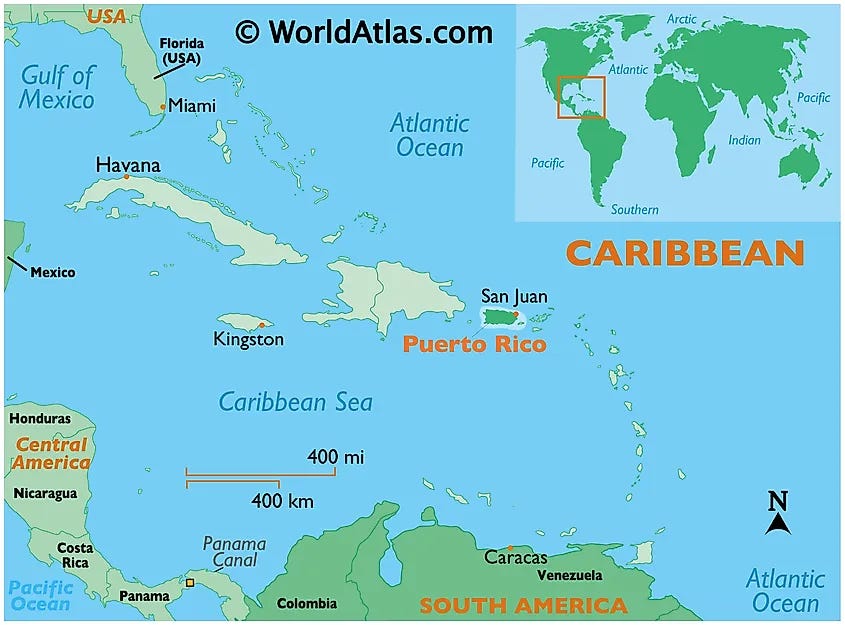Puerto Rico: The Caribbean State
Both parties agree on statehood, so why hasn't it seen a vote in Congress?
Puerto Rico Overview
Total Population: 3.2 million
Capital City: San Juan, PR
Prospective # of House Seats: 5
Puerto Rico is an archipelago made up of the eponymous main island and several smaller satellite islands. It lies roughly 1,000 miles off the coast of Florida in the Caribbean Sea. The commonwealth is both the largest United States territory in terms of land area (roughly the size of Connecticut) and is also the most populous territory at 3.2 million residents. If Puerto Rico was ranked among US states by population it would rank 30th, just ahead of Nevada, Utah and Iowa.
Statehood History
Puerto Rico was first colonized by Spain with the arrival of Christopher Columbus in 1493. Despite remaining under Spanish rule for over four centuries, Puerto Rico’s early human history mirrors that of the United States: displacement of the native population, importation of African slaves, and the emergence of a unique, multi-cultural identity. The islands changed hands in 1898 when Spain relinquished control to the United States at the close of the Spanish-American War.
Barely two decades after coming under the control of the US, the Puerto Rican government held a unanimous vote in favor independence. This went ignored by the US government and its residents were officially considered US citizens in 1917 with the passage of the Jones-Shafroth Act. Puerto Rico was officially organized as a commonwealth in 1952 followed by a US-led proposal to hold a constitutional convention for the islands.
Since organizing as a commonwealth in the early 1950s, Puerto Rico has put statehood to a vote a total of seven times, with three of those votes happening within the last ten years. While each vote proposed slightly different ways of incorporating the islands into a state, the referendums nearly always polled staying under US rule vs. full independence as its own sovereign country. According to the vote results independence has never been all that popular among Puerto Ricans, with at most 5% indicating support in 2012. Meanwhile, the push for statehood has had consistent support but has not always been popular among a majority of voters.
Puerto Rican statehood has been the dividing line for the state’s political parties as both of the current major parties define themselves around their support or opposition to statehood. The commonwealth’s New Progressive Party (PNP) was formed in 1967 out of the Republican Statehood Party by members who were upset by the latter party’s request that its members sit out on the year’s plebiscite. The opposing party to the PNP, the Popular Democratic Party (PPD), advocates for the continued commonwealth status of the islands. As a result, the many plebiscites held to determine Puerto Rico’s status are often proxies for each of the major party’s support on the island. (e.g. Recent support for statehood correlates with the New Progressive Party ascendance in both of the Commonwealth’s houses of state government, holding majorities between 2016 and 2020.)
Regardless of the method in which the islands gain self-determination, most Puerto Ricans are in agreement that the status quo does not provide adequate representation to island residents in the US federal government. Since Puerto Rico is an unorganized territory within the United States, its residents do not vote in presidential elections, have no representation in the Senate and can only send non-voting representatives to the House. It wasn’t until 1947 when residents were given the ability to elect their own governor. (The position was previously appointed by the President of the United States.) While Puerto Ricans are exempt from paying federal taxes on personal income, they are still subject to other federal taxes for welfare programs like Social Security and Medicaid.
Despite few concrete movements from Congress to admit Puerto Rico as the 51st state, both major mainland political parties have come out in support of Puerto Rico statehood. Democrats have consistently supported the islands’ self-determination and the movement was given special attention by President Bill Clinton who established the President’s Task Force on Puerto Rico’s Status. Even in the face of shifting ideologies, Republicans have signaled unwavering support for Puerto Rico statehood in every party platform released since 2008. (Although, Mitch McConnell has recently been quoted opposing statehood.) As far as I can tell, no other present-day statehood movement has received such support from both parties. It seems as though Puerto Rico is on the fast-track to become the coveted 51st state. The problem is that statehood must pass through a gridlocked Congress that struggles to pass just about anything, even widely popular legislation. While conversations are ongoing surrounding Puerto Rico’s status, putting the proposal to an official vote does not seem to be a top priority for this Congress.




